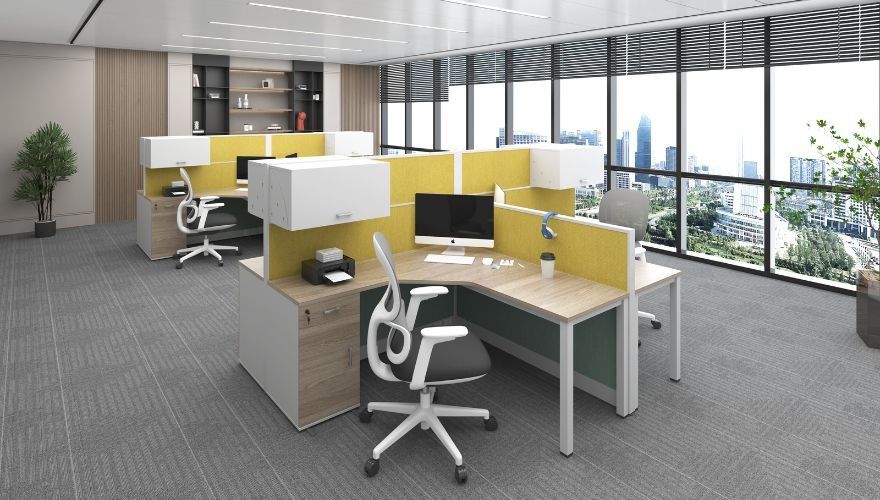An office workstation is more than just a desk and chair; it’s a space where employees spend the majority of their workday. The design and functionality of these workstations significantly influence productivity, comfort, and overall job satisfaction. A well-thought-out setup can inspire creativity and focus, while a poorly designed one can hinder performance. Here’s a closer look at how office workstations impact employee productivity and what factors contribute to an efficient workspace.
1. Ergonomics: The Foundation of Productivity
Ergonomics is critical when it comes to designing an effective workstation. An ergonomically sound setup reduces the risk of physical discomfort and injuries such as back pain, neck strain, and repetitive stress disorders. Adjustable chairs, height-appropriate desks, and proper monitor positioning are all vital components of ergonomic office furniture.
When employees are comfortable, they’re less likely to experience fatigue or distractions caused by discomfort. This, in turn, leads to better focus and sustained productivity throughout the day.
2. Layout and Space Optimisation
The physical layout of a workstation has a direct impact on an employee’s ability to perform tasks efficiently. Cluttered or cramped spaces can create a sense of disorganisation, making it harder to concentrate. On the other hand, workstations that are spacious and well-organised encourage a streamlined workflow.
Using modular office furniture can help maximise available space while allowing for customisation based on individual or team needs. Flexible layouts also make it easier to adapt to changing work requirements, further enhancing productivity.
3. Lighting and Its Effects on Focus
Lighting is often overlooked, yet it plays a crucial role in employee performance. Poor lighting can lead to eye strain, headaches, and fatigue, all of which reduce productivity. Workstations positioned near windows benefit from natural light, which has been shown to boost mood and energy levels.
For spaces where natural light is limited, task lighting such as adjustable desk lamps ensures employees have sufficient illumination to work comfortably. Pairing these with thoughtfully chosen office furniture creates an environment that supports focus and efficiency.
4. Noise Levels and Privacy
Open-plan offices are popular for fostering collaboration, but they can also lead to increased noise levels and distractions. A well-designed workstation can mitigate these issues by incorporating acoustic panels, privacy screens, or even noise-cancelling furniture solutions.
Providing employees with a sense of privacy, whether through partitioned desks or quiet zones, allows them to concentrate better on individual tasks. Striking the right balance between open collaboration areas and private workspaces is key to maintaining high productivity.
5. Technology Integration
Modern workstations must accommodate a variety of technological needs, from computers and monitors to charging stations and cable management systems. A clutter-free workstation with integrated technology solutions ensures that employees can access their tools efficiently without wasting time dealing with tangled wires or misplaced devices.
For example, desks with built-in power outlets and cable trays not only look sleek but also enhance functionality. This seamless integration of technology with office furniture helps create a workspace that is both practical and aesthetically pleasing.
6. The Psychological Impact of Design
The design of a workstation goes beyond physical functionality; it also affects an employee’s mental well-being. Colours, textures, and overall aesthetics contribute to the atmosphere of a workspace. Bright and vibrant colours can stimulate creativity, while neutral tones may promote calm and focus.
Investing in high-quality, visually appealing office furniture sends a message to employees that their comfort and satisfaction are valued. This sense of appreciation can boost morale and, in turn, productivity.
7. Flexibility and Personalisation
No two employees work in exactly the same way, so providing flexibility in workstation design is essential. Adjustable desks, moveable storage units, and customisable layouts allow employees to tailor their workspaces to suit their preferences.
When employees have the freedom to personalise their workstations, they feel a greater sense of ownership and comfort. This autonomy can lead to increased motivation and productivity, as individuals are more likely to thrive in a space that reflects their needs and work style.
8. Collaboration vs. Focused Work
Different tasks require different environments. While collaborative projects benefit from shared spaces and open layouts, focused work often demands quiet and private areas. Designing workstations that cater to both types of activities ensures employees can switch between collaborative and individual tasks without compromising efficiency.
For instance, modular office furniture can be reconfigured to create team zones or individual pods as needed. This adaptability fosters a dynamic work environment where productivity flourishes.
9. Health and Wellness Considerations
Workstations that support employee health and wellness directly impact productivity. Sit-stand desks, ergonomic chairs, and anti-fatigue mats promote movement and reduce the physical strain of prolonged sitting.
Incorporating wellness features into workstation design not only improves physical health but also enhances mental well-being. Employees who feel physically and mentally supported are more likely to remain engaged and productive throughout the workday.
10. The Role of Office Furniture in Productivity
Office furniture is the backbone of any workstation. It provides the structure upon which all other elements are built. From ergonomic chairs that ensure comfort to desks that optimise space, the quality and design of office furniture have a profound impact on employee productivity.
Investing in versatile, durable, and aesthetically pleasing furniture ensures that workstations remain functional and inviting. It’s not just about meeting basic needs; it’s about creating an environment where employees can perform at their best.
Designing for Success
A thoughtfully designed office workstation does more than provide a place to work—it fosters an environment of efficiency, comfort, and inspiration. By prioritising ergonomics, layout, and personalisation, and pairing these with high-quality office furniture, businesses can create workspaces that truly enhance productivity. The right workstation setup isn’t just an investment in furniture; it’s an investment in employee success.

Leave a Reply